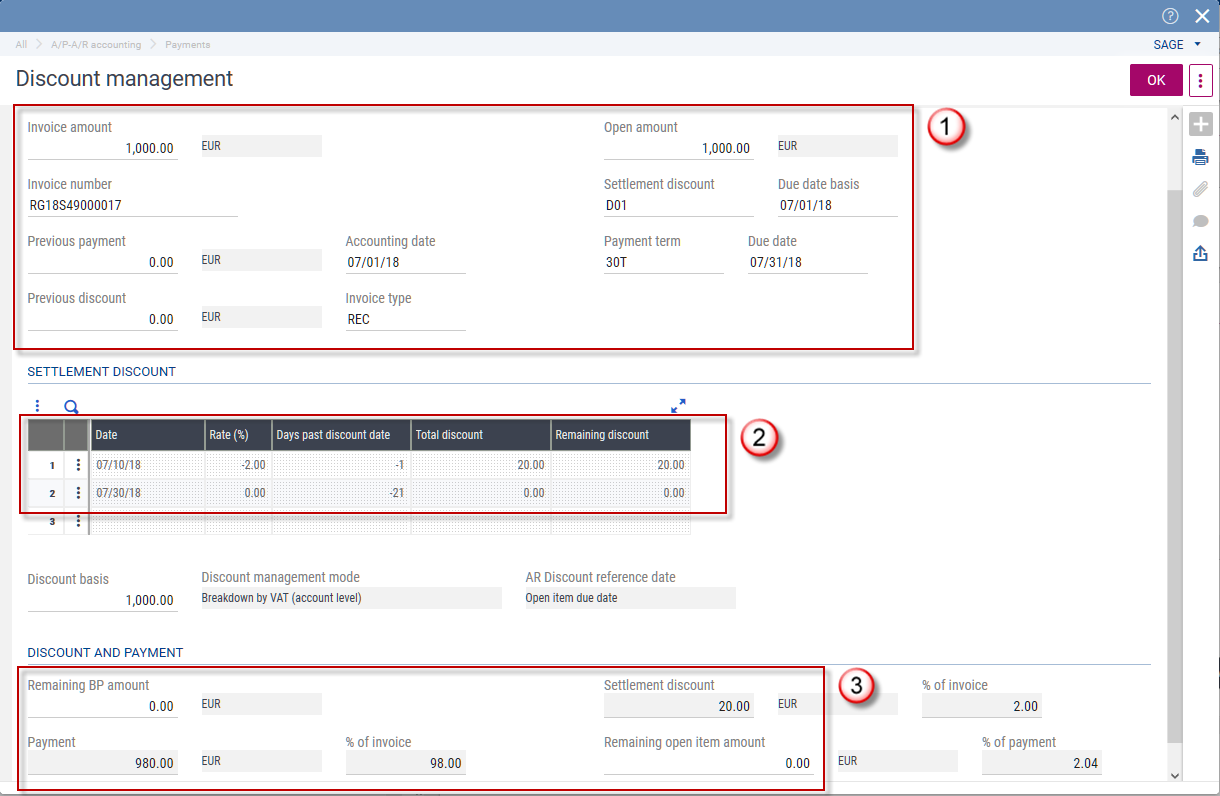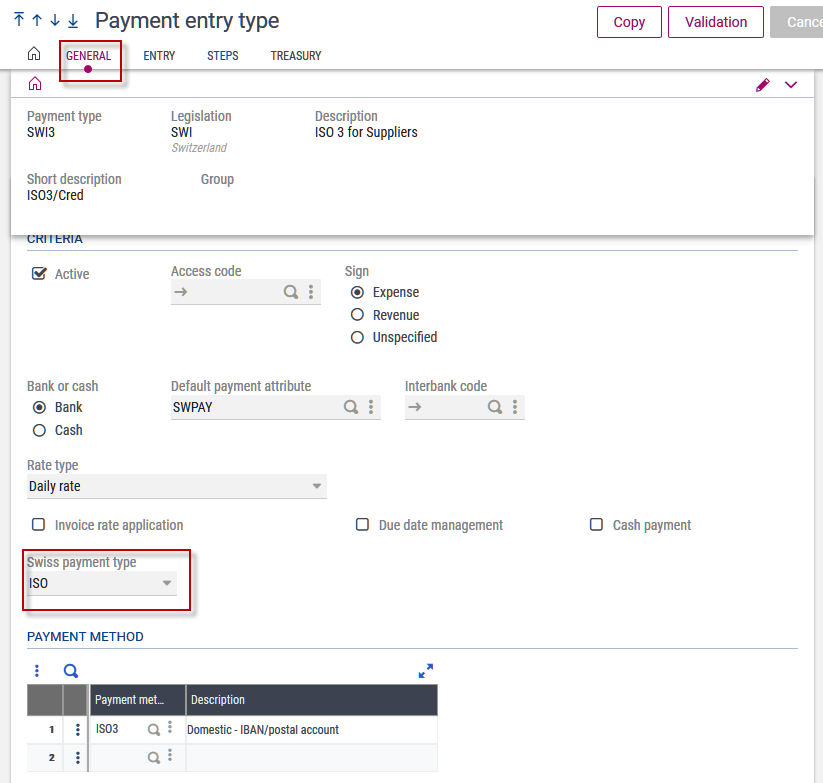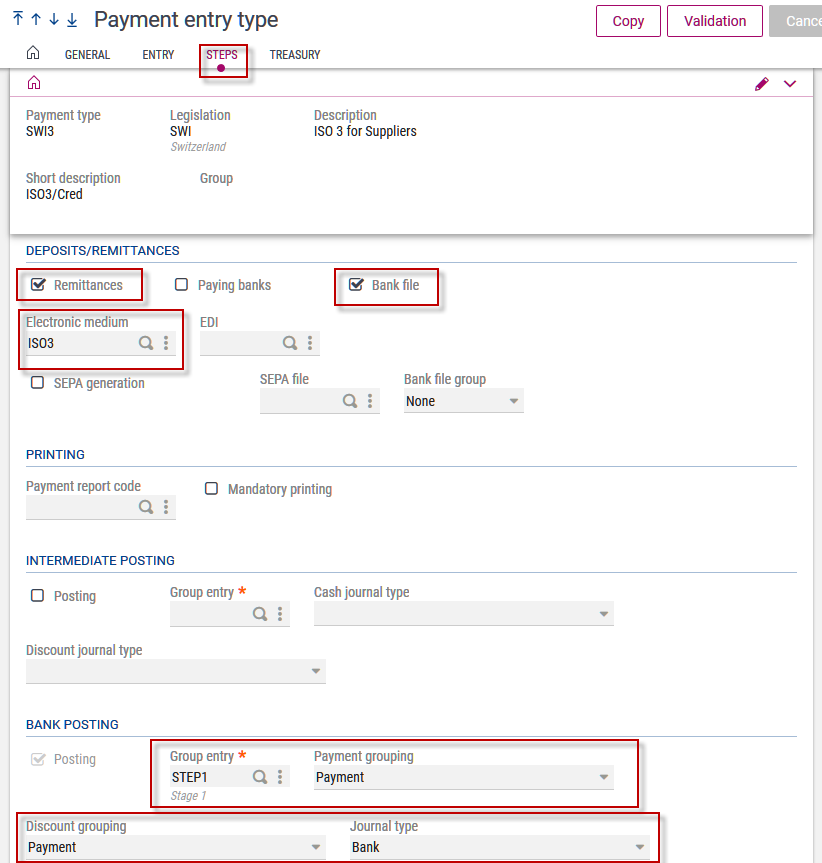Swiss payment functions
The Swiss payment functions include creating bank files according to the Swiss Implementation Guidelines for ISO 20022 based payment messages:
- Customer Credit Transfer Initiation (pain.001) with transaction types 1, 2.1, 2.2, 3, 4, 5, 6
- Direct Debit Transfer Initiation (pain.008) with transaction type CH-DD (Postfinance Direct Debit)
The payment functions follow the standard workflow for creating payment transaction files. However, several specific settings and steps are required.
Bank statements with the CAMT.053/054 format can be imported through the advanced bank statement import process including automatic matching of open items. For more details, refer to the how to guide on the advanced bank statement import process.
You can also import ISR bank files with the list of received ISR payments using automatic open item allocation.
Prerequisites
These activity codes must be active.
- KSW - Swiss localization
- VII - International transfers
- LOCSCRACT - Bank detail window activation (TC chapter, INT group):
This defines if the local screens should be used for bank details entry.
The following parameters are in the LOC chapter, SWI group:
- BVRDEP - Early discount on customer:
This defines if discount should be calculated for customers (import ISR bank file). - BVRENDINV - To Swiss ISR/QR invoice:
This defines end position of invoice number in ISR reference number (import ISR bank file). - BVRNUMERIC - Swiss DTA/EZAG numeric:
This defines if the file name of the bank file should be formatted (leading zeros) or not (replenishment with space characters at the end). - BVRSTRINV - From Swiss ISR/QR invoice:
This defines start position of invoice number in ISR reference number (import ISR bank file). - DEFBANCRG - Default bank charge bearer:
(possible values: Shared, Beneficiary, Applicant), used for the payment creation for the initialization of the field "Bank charge bearer." This specification is not possible for every payment type. - DEVAMT - Max. amt. deviation ISR import (import ISR bank file)
- DEVPRC - Max. %. deviation ISR import (import ISR bank file)
- SWIBVRTPY - Payment type for ISR import:
This defines payment transaction for payment generation when reading an ISR bank file (import ISR bank file). - SWIPAYBAN - Swiss bank for charges:
Enter the company’s bank account that should be charged with possible bank charges. This information is transferred to the bank in the bank file (entry slip), if required for the respective payment format. - SWIPAYBVR - Control of Swiss payments:
This is for consistency checks Switzerland and is a default parameter for Swiss localization. - SWIPAYQR - Control of Swiss QR payments:
This is for consistency checks Swiss QR-bill payments and is a default parameter for Swiss localization. - TOLDEP - Discount tolerance in days (import ISR bank file)
Bank file definitions
Abrir: Setup > A/P-A/R accounting > Files > Bank file
To generate the ISO 20022 based Swiss payment files, the standard function is used to define bank file formats, which defines the structures of the file to be generated. The bank file definitions required to support these transaction types are delivered with the Swiss localization:
- ISO1: Domestic - ISR
- ISO21: Domestic - IS 1-stage
- ISO22: Domestic - IS 2-stage
- ISO3: Domestic - IBAN/postal account
- ISO3QRC: Domestic - IBAN and QR-bills. This definition can be used instead of definition ISO3 as of June 30, 2020.
- ISO4: Domestic - Foreign currency
- ISO5: Foreign SEPA
- ISO6: Foreign – SWIFT
- CHDDPF: Postfinance Direct Debit
Changes should only be made to copies of the standard bank file definitions so that your adjustments are not overwritten when the standard bank file definitions are updated.
Batch booking
By default, the batch booking (<BtchBookg></BtchBookg>) field in the bank file definitions is set to true. This groups the financial institution bookings into collective items on its company bank account (as far as possible). If this value is set to false, one booking is made per payment transaction on its company bank account.
Payment methods
Abrir: Common data > BP tables > Payment method
Dedicated payment methods are required for processing the different payment transactions, one for each ISO payment type.
The following payment methods are created in the delivery folder:
- ISO1
- ISO21
- ISO22
- ISO3
- ISO4
- ISO5
- ISO6
These methods can be used for Postfinance and for other banks.
The Swiss payment types must contain the value corresponding to the transaction type in the Type field according to the table below. For all types listed, the Swiss payment type must be ISO.
|
Default payment method |
Payment type number* |
Used for |
Creditor (destination) account information** |
Type field values |
|---|---|---|---|---|
|
ISO1 |
1 |
ISR payment |
ISR participation number |
1 |
|
ISO21 |
2.1 |
IS 1-stage to postal account |
Postal account |
201 |
|
ISO22 |
2.2 |
IS 2-stage to bank account |
IBAN or bank account or code line entry IID, IID and postal account of bank or postal account and name of bank |
202 |
|
ISO3 |
3 |
Domestic payment to IBAN, postal account or bank account in CHF/EUR |
IBAN or postal account or bank account IID or domestic BIC |
3 |
|
ISO4 |
4 |
Domestic payment in foreign currency |
IBAN, postal account or bank account Domestic BIC or IID and name/address bank. |
4 |
|
ISO5 |
5 |
Foreign SEPA payments in EUR |
IBAN |
5 |
|
ISO6 |
6 |
Foreign payments |
IBAN or account number BIC or name/address of bank |
6 |
*Payment type numbering according to Swiss ISO 20022 documents
**Creditor account information: This account information must be supplied as minimum information in the bank details management fields for the supplier.
Other Swiss payment type field values:
- Print: to be used only for payment types for which an slip (ISR) is printed (= customer payment types for customer invoices)
- Non-ISR: to be used for payments for which no payment file is generated (for example, manual bank entries, cash payments, etc.)
- DTA or EZAG: old payment transaction formats, no longer maintained
Additional options in the Management block are not supported for Swiss payment methods.
Payment entry transactions
Abrir: Setup > A/P-A/R-accounting > Payment entry transactions
Each payment needs to have a preconfigured payment etnry transaction in the delivery folder:
- SWI1… SWI6
Pay particular attention to the following settings:
General
- Swiss payment type: Select ISO.
- Payment mode table: Enter the corresponding ISO payment type. You cannot use different payment types.
Steps
- Deposits/Remittances block:
Select the Remittances and Bank file checkboxes.
In the Electronic medium field, select the corresponding ISO bank file definition. - Bank posting block:
For Group entry, select STEP1.
For the Payment grouping and Discount grouping fields, select Payment.
Set Journal type to Bank.
The following fields can be displayed for additional information, but they are not required for the payment transaction:
- IPI code (DTA)
- Instruction key EZ (EZAG)
- Instruction key DT (DTA)
- Bank charge bearer (both formats)
You can enter additional instructions for the payment transaction. Contact your bank for more information.
Bank file generation
Create payments in the Swiss ISO standard with the same basic process for bank payment creation.
- When entering supplier invoices, select a payment term with the correct payment type such as ISR or another payment type.
- Create payments or payment entry batches through the Payment proposal function (PAYPROPAL) or through the Payment/receipt entry function (GESPAY).
- Create a remittance through the Manual remittance creation function (GESFRM).
- Use the Bank file function in the Manual remittance creation function to create the payment file for the remittance.
- After successfully delivering the file to the financial institution, you can post the remittance to create the bank postings in Sage X3.
Payment proposal
Abrir: A/P-A/R accounting > Payments > Payment proposal
When creating payment proposals in the Payment proposal function (PAYPROPAL) consider the following:
- Separate your payment proposals by payment entry transaction and/or ISO payment types. Mixing ISO payment types in a single payment file can lead to a rejection of the file by the financial institution because some payment types require different information in the file.
- Separate your payment proposals by currency or align with your bank if and how they can handle mixed currencies on one “B-level.”
Payment/receipt entry
When creating payments through the Payment/receipt entry function (GESPAY), consider the following:
- Separate your payments by ISO payment types. Mixing ISO payment types in one payment file can lead to a rejection of the file by the financial institution as some payment types require different information in the file (see appendix on technical information on Swiss ISO 20022).
- Separate your payments by currencies or align with your bank if and how they can handle mixed currencies within one “B-level” (see appendix on technical information on Swiss ISO 20022).
- When picking open items in the left list you should leave the Payment method field (PAM) empty. The payment method will then be set according to the payment method of the open item.
- If a payment contains several open items, they must have all the same ISO payment type. Otherwise the payment method of the first open item is used for the payment.
Creating a manual remittance
The next step is to create a remittance. For this, you can create a new remittance and add the previously created payments or payment batches.
To create the Swiss payment file, click Execution date in the Action panel under Functions.
This opens a screen where you must enter the desired execution date. Click OK to start the bank file generation. After successfully creating the bank file, you receive a message indicating the file name of the generated file. The bank file is generated in the bank file output volume (default value [BQE]).
- One bank file per remittance is created.
- Separate your payments by ISO payment types and currencies.
After successfully delivering the file to the financial institution, you can post the remittance to create the bank postings in Sage X3.
Import ISR bank file
The ISR bank file import functions can be found in A/P-A/R accounting > Bank transactions > Swiss legislation.
You can use the Import Swiss ISR file function (SWIIMPBVR) to import ISR payment files and allocate them to the corresponding invoices.
There are two kinds of files:
|
Type |
Description |
|---|---|
|
3 |
ISR payment in CHF |
|
4 |
ISR payment in foreign currency |
The SWIBV counter determines a unique import counter.
Imported payments can have different states. This can be recognized by the color:
|
State |
Description |
|---|---|
|
Black |
The line is correct. The payment is generated and validated and will be allocated to the open item. |
|
Orange |
There are differences between the invoice found and the value in the file. The payment cannot be generated. You must manually allocate another invoice number. |
|
Blue |
The system cannot allocate an invoice. You must manually allocate an invoice number. |
By clicking Validation, payments are automatically generated for all black lines, allocated to the invoices and validated.
It is also possible to leave the Import Swiss ISR file function without validating. Later, it is possible to reload and valuate the current state of the imports via the Current Swiss ISR import function.
Discount entry screen
When entering payments manually in the Payment/Receipt entry function (GESPAY), you have the option to activate an advanced discount entry screen that can simplify checking, entering and changing discount amounts.
Parameters and triggering conditions
These parameters are in the TRS chapter, TDC group.
AUTDEPCUS - Auto calc AR discount taken:
Yes: automatic discount suggestion
No: no automatic discount suggestion
DEPMSK - Early discount mask:
If AUTDEPCUS is Yes, this parameter controls whether the discount entry screen is used for the discount suggestion or whether only one discount line is inserted automatically.
Yes: discount entry screen active
No: discount suggestion without discount entry screen
The standard payment attributes of the corresponding parameters in the TRS chapter, TDS and PAY groups, or the payment entry screen are used to create the payment or discount lines.
The discount entry screen opens if the following conditions are met:
- AUTDEPCUS is set to Yes.
- DEPMSK is set to Yes.
- The payment is an incoming payment.
- The open item has a discount condition.
- This is a discount deduction, not a late charge.
Process
Using the discount entry screen supplements the basic procedure in the Payment/receipt entry function (GESPAY) as follows:
- Enter the header information of a new payment.
- In the selection list under Open items, search for the item to be paid and accept it by clicking on it.
- When you click on it, the system checks whether a discount suggestion has been made and whether the other conditions for the discount entry screen have been met. If Yes, the discount entry screen opens with the suggested discount values:

Section 1: Invoice information including previous payments/discount deductions.
Section 2: Discount details including calculated discount amounts. Values can be transferred to the payment fields using a line action.
Section 3: Suggested payment/discount amounts, can be modified. It is also possible to enter percentages.
- If required, you can modify the suggestion in the Discount and payment section. By clicking OK, the discount deduction is transferred to the payment entry screen and a corresponding payment and discount line is inserted.

- You can now save the payment or add further open items to this payment.




